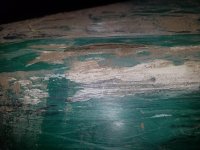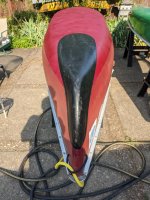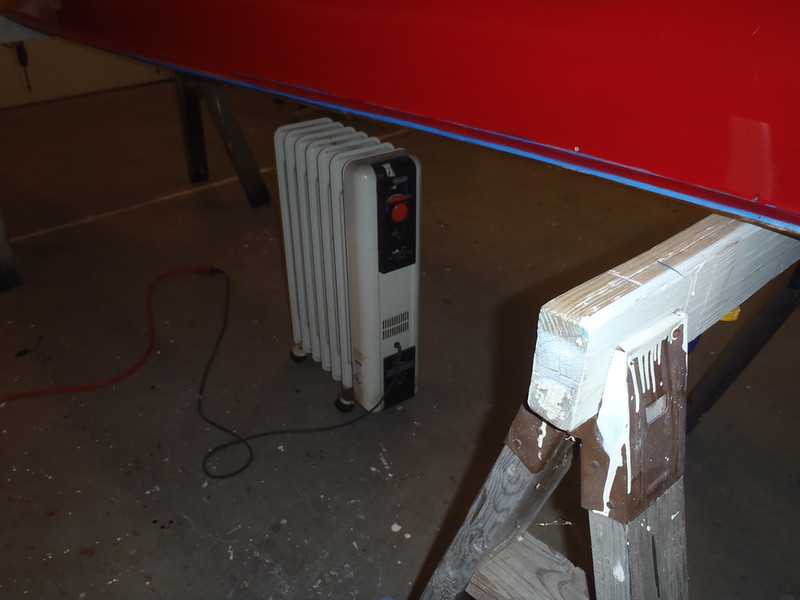I don't know if we are looking at the bow or the stern. I can tell you that anywhere the green has worn off is exposed ABS that is subject to UV degradation and needs to be covered with something opaque, paint if nothing else. So if there is any area of hull that is missing green vinyl that is not covered with your abrasion plate, paint it with any type of paint that most closely matches the color of the hull and accept the fact that you will never get an exact color match. An alternative is to mark off a 3" waterline and just paint everything below it. If you go that route I would suggest Pettit Easy Poxy paint.
As for the abrasion plate, yes I agree that Kevlar felt sucks. Its only virtue is that it is easy for those unfamiliar with laminating with fabric and epoxy to use since it does not fray at the edges and maintains its shape. But it stands way proud of the adjacent hull surface, is difficult to nicely feather into the surrounding hull because of the tendency of aramid to fuzz up when sanded, it soaks up a lot of resin, and for its final weight a Kevlar felt skid plate is actually pretty weak. The Kevlar fibers are individually strong but like all felt materials it consists of short, compressed fibers. When Kevlar felt skid plates receive a good hit it is very common for a sizable chunk of irregularly shaped material to break off.
You have a Royalex canoe. Far and away the best epoxy to use is straight West System G Flex. It will give a better bond than conventional epoxies like West 105/205-206 of a mix of that and G Flex. And for the repair you have at hand the smallest quantity of G Flex you can buy will be enough to do the repair and apply and abrasion plate. Straight G Flex epoxy is more viscous than conventional epoxy and it takes a bit longer to wet out fabric but it does just fine with all plain weave fabrics I have used up to 6 ounce/square yard weight including Kevlar, fiberglass, Dynel, and carbon fiber. Warmer ambient temperatures or gently warming the mixed epoxy prior to application will reduce viscosity if need be.
You have an area of exposed foam core in the photograph that should be filled in prior to application of an abrasion plate. I would use G Flex epoxy moderately thickened with silica powder for this allowing it to settle into the "pores" of the foam core and repeating the application until the area is slightly overfilled. Then after the epoxy is cured you can sand it fair and flush trying to maintain the curvature of the hull contour.
Either 5 ounce/square yard Dynel fabric or 6 ounce/square yard S fiberglass are excellent for abrasion plates. Or you could lay down a layer of S 'glass and cover it with a Dynel abrasion plate. Dynel fabric has a bit less tendency to fray at the edges. Fraying will also be reduced by cutting out the fabric for your abrasion plate "on the bias". In other words, situate the fabric so that the fibers of the weave and weft cross the long axis of the canoe at 45 degree angles. I like to mix graphite powder into the epoxy used to apply abrasion plates but you can also just paint it after the epoxy has cured and been washed.
Here is an old thread that contains a lot of "tricks" for applying abrasion plates:
https://www.canoetripping.net/forum...ussions/diy/17299-​skid-plates-an-evolution









